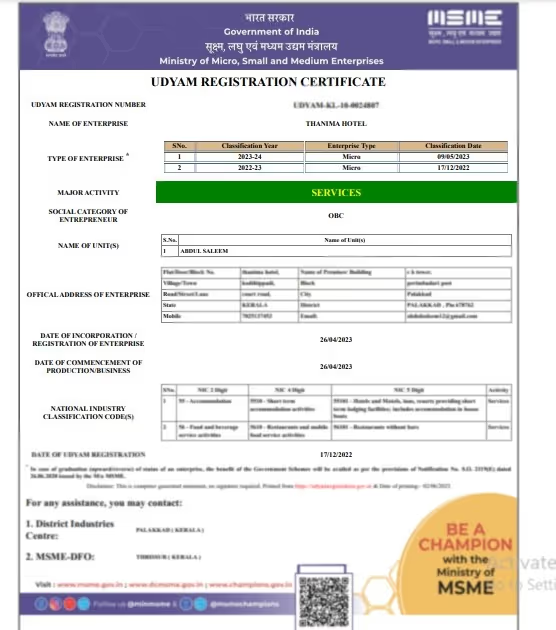If you run a business like a partnership firm, LLP, or a registered society and want to turn it into a private or public limited company, you can do so under Section 366 of the Companies Act, 2013. To support such conversions, the Ministry of Corporate Affairs (MCA) notified the Companies (Authorised to Register) Second Amendment Rules, 2018 on 20th September 2018, which became effective from 2nd November 2018.
These rules introduced a revised version of eForm URC-1, a crucial form used to initiate the registration of an existing entity as a company. The form is prescribed under the Companies (Authorised to Register) Rules, 2014, and is directly linked to the provisions of Section 366. The amendment aimed to simplify the conversion process, provide legal clarity, and strengthen regulatory compliance. The following section explains the purpose and significance of filing Form URC-1 in detail.
Table of Contents
Form URC-1
Form URC-1, also known as the "URC 1 form", is an e-form prescribed under Rule 3(2) of the Companies (Authorised to Register) Rules, 2014. It enables various business entities, including partnerships, LLPs, societies, and others, to register as companies under Section 366 of the Companies Act, 2013. The form plays a crucial role in facilitating the formal registration process when an entity decides to transform its business structure into a company.
Filing Form URC-1 is mandatory for entities opting to convert into a company under the provisions of the Companies Act. It captures comprehensive details about the existing entity, the proposed company, and the compliance requirements for a smooth transition. By submitting this form, entities can initiate the company registration process and ensure adherence to the legal framework governing such conversions.
What is Section 366 of the Act?
Section 366 of the Companies Act, 2013 is a pivotal provision that allows various business entities, such as partnerships, LLPs, and societies, to register as companies under the Act. A significant amendment to this section, based on the recommendations of the Company Law Committee, reduced the minimum member requirement from seven to two, making it easier for smaller entities to convert into companies.
The scope of Section 366 has evolved since its introduction in the Companies Act, 1956. The 2017 amendments aimed to widen the eligibility criteria for registration, enabling more businesses to benefit from the advantages of operating as a company. This provision offers a streamlined pathway for entities formed under other laws to transition into the corporate structure governed by the Companies Act.
By registering under Section 366, entities can enjoy benefits such as limited liability protection, better access to capital, and enhanced credibility in the market. The provision creates a bridge between different legal frameworks, allowing businesses to adopt a more formal and regulated structure that aligns with their growth aspirations.
Companies that can be Registered under Section 366
Section 366 of the Companies Act, 2013 allows a wide range of entities to register as companies, including:
- Partnership firms
- Limited Liability Partnerships (LLPs)
- Cooperative societies
- Societies registered under the Societies Registration Act, 1860
- Any other business entity formed under other laws
These entities must have a minimum of two members to be eligible for registration under Section 366. They can convert into companies limited by shares, guarantee, or as unlimited companies.
It's important to note that Section 366 applies to entities originally formed under laws other than the Companies Act. It provides a pathway for these businesses to transition into the corporate structure and operate under the purview of the Companies Act, 2013.
This provision provides a legal pathway for such organisations to adopt a corporate structure, enabling them to operate under a more regulated framework while enjoying benefits like limited liability, perpetual succession, and enhanced legal status.
Purpose of Form URC-1
The primary purpose of Form URC-1 is to facilitate the registration of certain entities, such as partnerships, LLPs, and societies, as Part I Companies under the Companies Act, 2013. When an entity has seven or more members, Form URC-1 is filed along with Form INC-7 to initiate the company registration process.
Form URC-1 simplifies the online registration procedure by capturing all the necessary details and documents required for the conversion. It serves as a comprehensive application form that enables entities to provide information about their existing structure, proposed company details, and compliance with the legal requirements.
By filing Form URC-1, entities can ensure a smooth transition from their current legal status to a company registered under the Companies Act. The form helps in maintaining transparency and accuracy in the registration process, as it requires the submission of relevant documents and disclosures.
For entrepreneurs and startups, Form URC-1 acts as a practical tool, guiding them through the registration process and helping them understand the documents and disclosures needed for conversion.
Key Amendments and Implications
The Companies (Authorized To Register) Amendment Rules, 2023, introduced several significant changes to Form URC-1. The amended form now requires additional details, including:
The amendments aim to strengthen the due diligence process and ensure that all relevant information is disclosed during the registration process. By mandating the submission of these details, the MCA seeks to enhance the integrity and reliability of the information provided by the entities seeking to convert into companies.
The implications of these amendments are significant for entities considering registration under Section 366. They must ensure compliance with the new disclosure requirements and maintain proper documentation to support their application. The increased transparency and disclosures help in preventing any misrepresentation or concealment of material facts during the registration process.
Entities should carefully review the amended Form URC-1 and ensure that they have all the necessary information and documents ready before initiating the filing process.
Attachments to be submitted for Form URC-1
The amended Form URC-1 requires several mandatory attachments to be submitted along with the application. These documents provide supporting evidence and ensure compliance with legal and regulatory requirements. The key attachments include:
- Particulars of members/partners: A list of all members or partners of the existing entity, along with their details and shareholding pattern.
- Declaration by directors: A declaration by two or more proposed directors of the company, verifying the particulars of all members/partners.
- Affidavit for dissolution: An affidavit from all members/partners, confirming the dissolution of the existing entity.
- Instrument constituting the entity: A copy of the partnership deed, LLP agreement, or other instrument constituting or regulating the existing entity.
- Certificate of registration: A copy of the certificate of registration of the existing entity, issued by the relevant authority.
- No Objection Certificates (NOCs): NOC from any sectoral regulators or authorities, if applicable, depending on the nature of the business and the sector in which it operates
- Newspaper advertisement: A copy of the newspaper advertisement published in a English and a vernacular language newspaper, giving notice of the proposed registration.
- Compliance certificate: A certificate from a practicing professional (CA/CS/CWA), confirming compliance with the provisions of the Stamp Act, to the extent applicable.
- Consent of majority members: A resolution passed by a majority of members, agreeing to the registration of the entity as a company.
- Statement of Accounts: Optionally, a statement of accounts and a valuation report determining the value of assets and liabilities of the existing entity
These attachments provide critical information about the existing entity, its members, and the proposed company. The affidavit from members ensures their consent and commitment to the conversion process. NOCs from regulatory authorities help in identifying any sector-specific compliance requirements or approvals needed for the conversion. The consent and declarations from the first directors establish their eligibility and willingness to take on the responsibilities of directors in the newly registered company. The copies of incorporation documents and constitutional papers provide proof of the existing entity's legal status and governance framework.
Entities should ensure that all the required attachments are duly prepared, signed, and submitted along with Form URC-1. Incomplete or missing attachments may lead to delays or rejection of the registration application. It is advisable to maintain proper records and documentation to support the information provided in the form and the attachments.
Frequently Asked Questions
Private Limited Company
(Pvt. Ltd.)
- Service-based businesses
- Businesses looking to issue shares
- Businesses seeking investment through equity-based funding
Limited Liability Partnership
(LLP)
- Professional services
- Firms seeking any capital contribution from Partners
- Firms sharing resources with limited liability
One Person Company
(OPC)
- Freelancers, Small-scale businesses
- Businesses looking for minimal compliance
- Businesses looking for single-ownership
Private Limited Company
(Pvt. Ltd.)
- Service-based businesses
- Businesses looking to issue shares
- Businesses seeking investment through equity-based funding
One Person Company
(OPC)
- Freelancers, Small-scale businesses
- Businesses looking for minimal compliance
- Businesses looking for single-ownership
Private Limited Company
(Pvt. Ltd.)
- Service-based businesses
- Businesses looking to issue shares
- Businesses seeking investment through equity-based funding
Limited Liability Partnership
(LLP)
- Professional services
- Firms seeking any capital contribution from Partners
- Firms sharing resources with limited liability
Frequently Asked Questions
What is a company for registration under section 366?
A company for registration under Section 366 refers to an entity, such as a partnership firm, LLP, or society, that seeks to convert and register itself as a company under the Companies Act, 2013. This provision allows these entities to transition into the corporate structure and be governed by the regulations and compliance requirements specified in the Act.
What is Form 1 of the Companies Act?
Form 1 of the Companies Act, also known as Form INC-1, is an application form used for reserving a name for a proposed company. It is the first step in the company incorporation process, where the promoters or applicants propose a name for the company and seek approval from the Registrar of Companies (ROC) before proceeding with the incorporation formalities.
What are the Authorised to register rules for companies?
The Authorised to Register Rules for companies are a set of rules prescribed under the Companies Act, 2013, which govern the registration of entities as companies under Section 366. These rules provide the eligibility criteria, procedures, and requirements for entities seeking to convert into companies. The rules specify the forms to be filed, attachments to be submitted, and the overall process to be followed for a successful registration under Section 366.




















